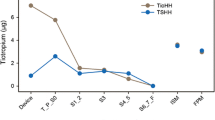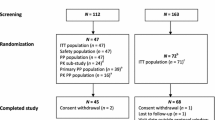Abstract
The acute safety of the alternative chlorofluorocarbon-free (CFC-free) propellant HFA-134a from a pressurized metered-dose inhaler (MDI) was assessed in 12 healthy male subjects according to a double-blind, randomized, crossover design. On each of three consecutive days, cumulative doses of 1, 2, 4, 8 and 16 inhalations were administered 30 min apart from one of three MDIs. The three MDIs contained either the HFA-134a CFC-free system without drug (HFA-Placebo), the CFC-free system with salbutamol sulphate (HFA-Salbutamol), or a conventional CFC propellant mixture without drug (CFC-Placebo). Pulmonary function (FEV1, FEF25–75%), cardiovascular performance (heart rate and blood pressure), objective tremor measurements and serum potassium were measured after each incremental dose.
Similar responses for pulmonary function, cardiovascular performance, tremor and serum potassium were observed between the HFA-Placebo and CFC-Placebo groups. No statistically significant difference was seen in change from baseline of any parameter between the two propellant systems. The administration of HFA-Salbutamol produced statistically significant dose-related increases in heart rate, systolic blood pressure and tremor and a significant dose-related decrease in serum potassium; these responses were expected based on cumulative doses of active drug. Blood samples for HFA-134a analysis were collected to measure systemic absorption of this propellant. Levels of HFA-134a between 200 and 700 ng · ml−1 were detected in all subjects given the CFC-free system. This study shows that acute inhalation of HFA-134a in a CFC-free system is as safe as a CFC propellant system. Salbutamol sulphate in the CFC-free system can be delivered in a dose-linear fashion, without any noticeable change in the safety profile of active drug.
Similar content being viewed by others
References
Newman SP (1990) Metered dose pressurized aerosols and the ozone layer. Eur Respir J 3:495–497
Konty MJ, Destefano G, Jager PD, McNamara DP, Turi JS, VanCampen L (1991) Issues surrounding MDI formulation development with non-CFC propellants. J Aerosol Med 4:181–187
Manzer LE (1990) The CFC-ozone issue: progress on the development of alternatives to CFCs. Science 249:31–35.
Boulden ME (1994) HFC-134a: the latest in propellant alternatives. Spray Technol Marketing 4:32–35
Dalby RN, Byron PR, Shepherd HR, Papadopoulos E (1990) CFC propellant substitution: P-134a as a potential replacement for P-12 in MDIs. Pharmacol Technol 14:26–33
Tansey IP (1994) Challenges in the development of metered dose inhalation aerosols using ozone-friendly propellants. Spray Technol Marketing 4:26–29
Lipworth BJ, McDevitt (1989) Beta-adrenoceptor responses to inhaled salbutamol in normal subjects. Eur J Clin Pharmacol 36:239–245
Simmone P, Borgia M, Torre L, Ventresca GP (1990) Dose response to inhaled salbutamol in chronic obstructive airways disease. Dur J Clin Pharmacol 39:365–368
Foucard T, Lonnerholm G (1991) A study with cumulative doses of formoterol and salbutamol in children with asthma. Eur Respir J 4:1174–1177
Teale C, Morrison JFJ, Page RL, Pearson SB (1991) Dose response to inhaled salbutamol in chronic obstructive airways disease. Postgrad Med J 67:754–756
Britton J, Tattersfield (1984) Comparison of cumulative and non-cumulative techniques to measure dose-response curves for beta agonists in patients with asthma. Thorax 39:597–599
Sheiner LB, Beal SL, Sambol NC (1989) Study designs for dose-ranging. Clin Pharmacol Ther 46:63–77
Quanjer PhH, Tameling GJ, Coates JE, Pedersen OF, Peslin R, Yernault J-C 1993) Lung volumes and forced ventilatory flows. Eur Respir J 6[Suppl 16]:5–40
Lipworth BJ, Struthers AD, McDevitt DG (1989) Tachyphylaxis to systemic but not to airway responses during prolonged therapy with high dose inhaled salbutamol in asthmatics. Am Rev Respir Dis 140:586–592
American Thoracic Society (1987) Standardization of Spirometry-1987 update. Am Rev Respir Dis 136:1285–1298
Cooper KM, Chang SF, Harrison LI (1994) Determination of the chlorofluorocarbon substitute 1,1,1,2-tetrafluoroethane (HFA-134a) in human and animal blood using gas chromatography with headspace analysis. J Chromatog B 667:85–93
Snedecor GW, Cochran WG (1967) Statistical methods (6th ed). Iowa State University Press, Ames Iowa, p 572
Robson DS (1959) A simple method for constructing orthogonal polynomials when the independent variable is unequally spaced. Biometrics 15:187–191
Donnell D, Harrison LI, Simmons J, Ekholm BP (1995) 28-Day safety study of the HFA-134a 3M CFC-free propellant system on healthy volunteers. Am J Respir Crit Care Med 151:A57
Ruffin R, Mitchell C, Thompson P, Hearle D, Cline A, Ekholm B (1995) Placebo controlled comparison of the dose-response effects of salbutamol sulphate in CFC vs HFA-134a propellants in asthmatics. Am J Respir Crit Care Med 151:A58
Bleecker ER, Klinger NM, Ekholm BP, Tinkelman (1995) Twelve week efficacy and safety comparison of salbutamol formulated with HFA-134a and standard CFC propellant systems. Am J Respir Crit Care Med 151:A58
Olsson P, Aigbirhio FI, Freemantle CAJ, Pike VW, Page BC, Rhodes CG, Waters SL, Ventresca GP, Tanner RJN (1994) Absorption and disposition of a non-chlorinated propellant, GR106642X (1,1,1,2-tetrafluoroethane, HFA-123a) as examined by 18F-labelling and whole-body counting in healthy subjects. Am J Respir Crit Care Med 149:A220
Finch JR, Dadey EJ, Smith SL, Harrison LI, Digenis GA (1995) Dynamic monitoring of total-body absorption by 19F NMR spectroscopy: one hour ventilation of HFA-134a in male and female rats. Magnet Reson Med 33:409–413
Dollery CT, Draffan GH, Davies DS, Conolly ME (1970) Blood concentrations in man of fluorinated hydrocarbons after inhalation of pressurized aerosols. Lancet ii:1164–1166
Paterson JW, Studlow MF, Walker SR (1971) Blood-levels of fluorinated hydrocarbons in asthmatic patients after inhalation of pressurized aerosols. Lancet ii:565–568
Price AH, Clissold SP (1989) Salbutamol in the 1980s, a reappraisal of its clinical efficacy. Drugs 38:77–122
Cooper KC, Harrison LI, Chang, SF (1995) Blood levels of HFA-134a in asthmatics. J Aerosol Med 8:90
Author information
Authors and Affiliations
Rights and permissions
About this article
Cite this article
Donnell, D., Ward, S., Harrison, L.I. et al. Acute safety of the CFC-free propellant HFA-134a from a pressurized metered dose inhaler. Eur J Clin Pharmacol 48, 473–477 (1995). https://doi.org/10.1007/BF00194337
Accepted:
Issue Date:
DOI: https://doi.org/10.1007/BF00194337




